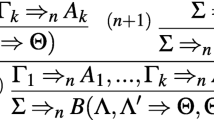Abstract
We present a new method of constructing a model of \(\lnot \)SCH+\(\lnot \)AP.
Similar content being viewed by others
Notes
This condition basically says that one entree given dense open set by taking a direct extension and then specifying finitely many coordinates. Usually, this property has the same proof, as the Prikry condition and is used to show that \(\lambda ^+\) is preserved in \(V^{{\langle }{{\mathcal {P}}},\le {\rangle }}\).
This is the crucial difference from the long extenders Prikry forcing \({\langle }{{\mathcal {P}}}\le , \le ^*{\rangle }\) of Sec. 2 of [3] The conditions in \({{\mathcal {P}}}\) consist basically of two parts one of cardinality \(<\kappa _n, (n<\omega )\) (assignment functions) and another of cardinality \(\kappa _\omega \) (Cohen functions). As a result, \({\langle }{{\mathcal {P}}},\le ^*{\rangle }\) collapses \(\kappa _\omega ^+\) and, as Asaf Sharon pointed out, \({\langle }{{\mathcal {P}}},\le , \le ^*{\rangle }\) adds \(\square ^*_{\kappa _\omega }\).
In the present setting both parts are put into one of cardinality \(\kappa _n\).
Either the Magidor or Easton support can be used for this.
References
Apter, A.: Laver indestructibility and the class of compact cardinals. J. Symb. Log. 63, 149–157 (1998)
Ben-Neria, O., Lambie-Hanson, C., Unger, S.: Diagonal supercompact Radin forcing. Ann. Pure Appl. Log. 171(10), 102828 (2020)
Gitik, M.: Prikry type forcings. In: Foreman, K. (ed.) Handbook of Set Theory, vol. 2, pp. 1351–1448. Springer, Berlin (2010)
Gitik, M.: Blowing up the power of a singular cardinal of uncountable cofinality. J. Symb. Log. 84(4), 1722–1743 (2019)
Gitik, M., Magidor, M.: Extender based forcings. J. Symb. Log. 59(2), 445–460 (1994)
Gitik, M., Sharon, A.: On SCH and approachability property. Proc. AMS 136(1), 311–320 (2008)
Shelah, S.: On successors of singular cardinals. In: Boffa, M., van Dallen, D., McAlloon, K. (eds.) Logic Colloquim, vol. 78, pp. 357–380. North-Holland, Amsterdam (1979)
Shelah, S.: Reflecting stationary sets and successors of singular cardinals. Arch. Math. Log. 31, 25–53 (1991)
Sinapova, D.: A model for a very good scale and a bad scale. J. Symb. Log. 73(4), 1361–1372 (2008)
Author information
Authors and Affiliations
Corresponding author
Additional information
Publisher's Note
Springer Nature remains neutral with regard to jurisdictional claims in published maps and institutional affiliations.
The work was partially supported by Israel Science Foundation Grants 58/14, 1216/18. We are grateful to the referee of the paper for her/his remarks and corrections.
Rights and permissions
About this article
Cite this article
Gitik, M. Another method for constructing models of not approachability and not SCH. Arch. Math. Logic 60, 469–475 (2021). https://doi.org/10.1007/s00153-020-00755-2
Received:
Accepted:
Published:
Issue Date:
DOI: https://doi.org/10.1007/s00153-020-00755-2




